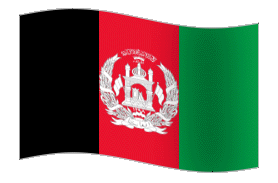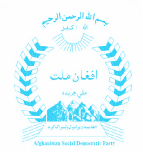دافغان ملت ملي مترقي ګوند

Afghanistan Social Democratic Party

Afghan Political Parties: Past, Present and Future
By: Ajmal Shams
The history of political parties in Afghanistan goes back to the period of King Zahir
Shah’s monarchy when the 1964 constitution legalized the formation of political and
social organizations. This freedom soon resulted into three major political movements
which can be broadly classified as Islamist, Marxist and Nationalist. Abdul Raheem
Niazai founded the Islamic group called Jawanan-
Each movement or party had its peculiar manifesto and a vision for Afghanistan and
each saw its ideology as the only panacea for all political and socio-
All the three major political movements were able to attract a large number of Afghans
towards their respective ideologies. Schools, colleges and universities became the
hub of political activities and student unions were formed in several universities.
Besides these major political parties, there also emerged minor parties like Shola-
In 1973, Sardar Mohammad Daud Khan, the former prime minister and cousin of King
Zahir Shah overthrew him in a bloodless coup with communists’ support. Eventually
Daud tried to eliminate the communists, but it was too late since the latter had
already established themselves very well in the civil and military bureaucracy. Daud
was overthrown by the communists in a bloody coup, killing him and all members of
his family thus ending Mohammadzai Dynasty in Afghanistan. Noor Mohammad Taraki became
head of the revolutionary council and president of the communist regime thus starting
an era of public uprising, instability, bloodshed and misfortune for the country.
The Pakistan-
The Afghan resistance against foreign invasion was broadly classified into two main
groups divided along ideological lines i.e. The Bunyadgara (Islamic radicals) and
Milligara (The Islamic nationalists or moderate Islamists). While there were more
than twenty political parties and groups, but Pakistan only recognized seven of these
and they alone were the recipient of all kinds of military, financial and political
support from both Pakistan and the West. The Bunyadgara included Hezb-
Besides the above seven parties, which were recognized by Pakistani government, there
were also other parties and pressure groups. The most significant among them was
Afghan Social Democratic Party well known as Afghan Mellat Party. Its founder president
Engineer Ghulam Mohammad Farhad was in Kabul and the party was led by Shamsul Huda
Shams, one of Afghan Mellat stalwarts and a nationalist politician. Afghan Mellat
was the main target of Pakistani government’s anger because of its nationalistic
agenda and its stance on Pakthunistan issue. This was the main cause of the party
being deprived of all kinds of military and financial assistance. Several members
of the party were harassed, terrorized and even assassinated since the extremist
parties had been given a free hand to suppress their ideological opponents. While
the seven recognized parties were highly divided among themselves, in their opposition
with nationalist Afghan Mellat they were all united. Being nationalist was equated
with being secular and un-
Inside Afghanistan, rapid political changes came one after another. Noor Mohammad
Taraki was replaced by hardliner Hafizullah Amin in a coup that resulted into the
former’s assassination. Amin believed more in home-
In spite of the fact that the Mujahideen parties were actively fighting against the
Soviet aggression, they had essentially been sidelined when it came to determining
the destiny of Afghanistan. When the Geneva Accords under which the Soviet troops
were to leave the country were signed, Mujahideen were not a signatory to it. Instead
the anomaly was that Pakistan was representing the Afghan Resistance. Furthermore,
the top commanders belonging to different Mujahideen parties had direct links with
Pakistani government. The military and financial aid, which in principle should
have been channelized through the parties, was instead delivered directly to the
commanders because it was assumed that dealing directly with them was more fruitful
for long-
Even after the Soviets left Afghanistan, they kept supporting Dr. Najibullah’s communist
regime and hostilities continued as ever before. After resisting for a few year Najibullah’s
regime was eventually overthrown in April 1992 through a military coup by an alliance
of his own commanders in collusion with some Mujahideen parties, the most prominent
being Jamiat-
Against this backdrop of chaos, lawlessness, complete anarchy and internecine fightings
the Taliban mysteriously emerged on the scene as religious reformers in 1994. They
claimed that the Mujahideen had been corrupted and did not to deliver on their promises
of establishing a truly Islamic government based on Sharia (Islamic Law) in the country.
In an astonishingly short span of time, the religious students were able to extend
their writ to large parts of the country eventually taking control of the capital
Kabul in 1996. The Taliban had their own ultra-
After the Taliban were overthrown in November 2001, Hamid Karzai was appointed as
the interim president of the country under the Bonn Agreement. Subsequently he won
the presidential elections in 2004 and hence became the first democratically elected
president of the country. Meanwhile a new constitution was drafted by a team of experts
and subsequently ratified by the Loya Jarga (the grand assembly) after lengthy deliberations
and discussions. The constitution has allowed the formation of political parties
and social organizations. These parties have to abide by and work within the framework
of the constitution. The parties are also required to get themselves registered with
Ministry of Justice in order to be officially recognized and benefit from their rights
and privileges. A new wave of democracy and freedom at the horizons of the country
has caused a party boom. So far more than 80 parties have been officially recognized
and more are on the waiting list. Many of the old parties have further split up into
two or more factions. For example Hezb-
While more and more parties will be formed in the future, their credibility will
remain in question unless they offer a more practical ideology within the confines
of National-
The role of political parties is crucial to strengthening democracy in the country.
Although party registration per se is a positive measure aimed at systematizing the
formation and activities of the political parties, the way it is being implemented
raises many questions as to whether the government by making the parties register
with a ministry might be trying to control them which is undemocratic in essence.
It is being argued that parties should be overseen by an independent election commission
instead of a ministry. There are also concerns that some of the high ranking government
officials who also happen to be leaders of their own political parties might be using
their office to harm their rival parties and benefit their own party members. Furthermore
the registration process should be simplified to avoid complications and unnecessary
curbs. While democratizing the war-
Copyright © Afghan Millat 2007-